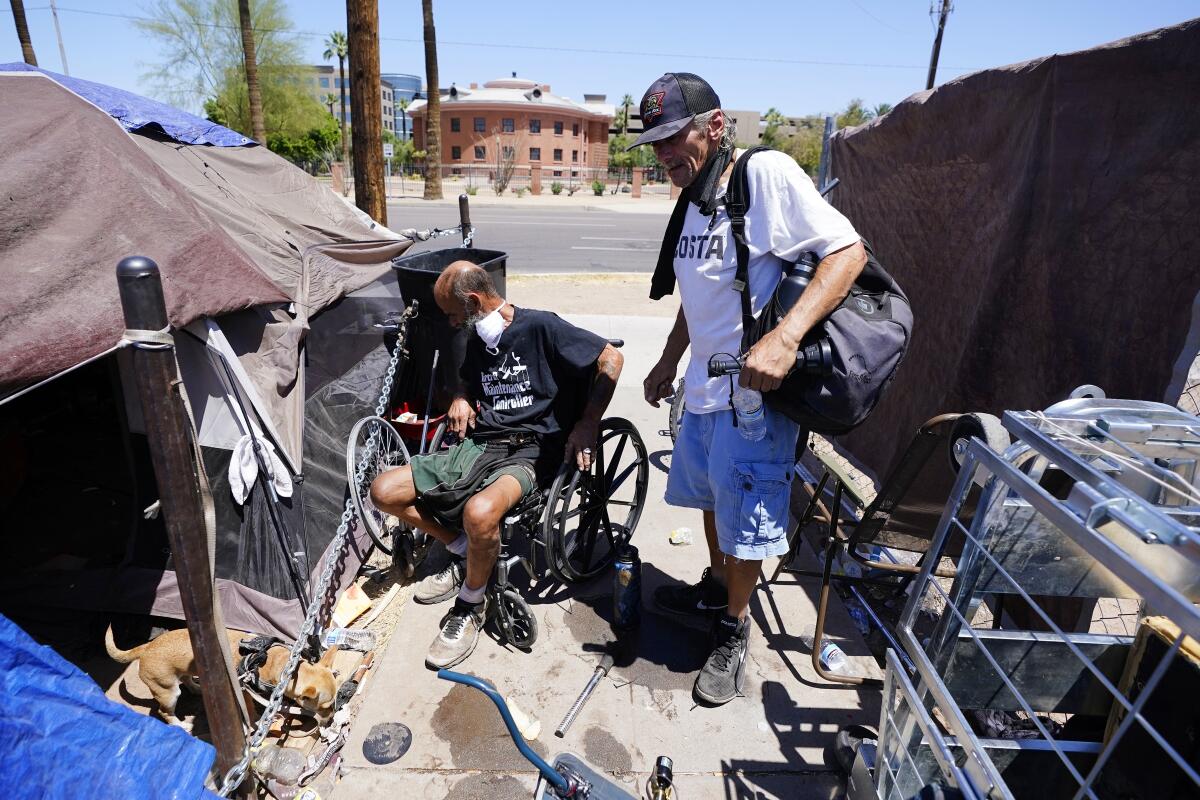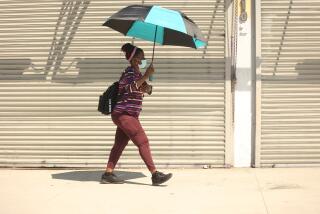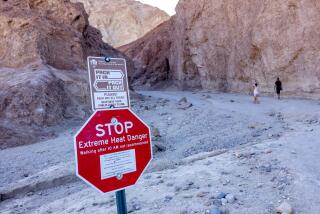Sweltering streets: Hundreds of homeless die in extreme heat each year

- Share via
PHOENIX — Hundreds of blue, green and gray tents are pitched under the sun in downtown Phoenix, a jumble of flimsy canvas and plastic along dusty sidewalks. Here, in the hottest big city in America, thousands of homeless people swelter as triple-digit temperatures arrive.
The stifling tent city has ballooned amid pandemic-era evictions and surging rents that have dumped hundreds more people onto streets that grow eerily quiet when temperatures peak in the midafternoon. Earlier this month, temperatures reached 114 degrees — and it’s only June. Highs reached 118 last year.
“During the summer, it’s pretty hard to find a place at night that’s cool enough to sleep without the police running you off,” said Chris Medlock, a homeless Phoenix man, known on the streets as “T-Bone,” who carries everything he owns in a backpack and often beds down in a park or desert preserve to avoid the crowds.
“If a kind soul could just offer a place on their couch indoors, maybe more people would live,” Medlock said at a dining room where homeless people can get some shade and a free meal.
Heat causes more weather-related deaths in the United States than hurricanes, flooding and tornadoes combined. Around the country, heat contributes to some 1,500 deaths annually; advocates estimate that half of those fatalities are among homeless people.
Temperatures are rising nearly everywhere because of global warming, combining in some places with brutal drought to create more intense, frequent and longer heat waves. The past few summers have been some of the hottest on record.
In the county that includes Phoenix, at least 130 homeless people were among the 339 individuals who died from heat-associated causes in 2021.
“If 130 homeless people were dying in any other way, it would be considered a mass casualty event,” said Kristie L. Ebi, a professor of global health at the University of Washington.
It’s a problem that stretches across the United States. With rising global temperatures, heat is no longer a danger only in places like Phoenix.
This summer will likely bring above-normal temperatures to most land areas worldwide, according to a seasonal map created by volunteer climatologists for the International Research Institute at Columbia University.
Last summer, a heat wave blasted the normally temperate U.S. Northwest, leaving Seattle residents sleeping in their yards and on roofs or fleeing to hotels with air conditioning. Across the state, several people presumed to be homeless died outdoors, including a man slumped behind a gas station. In Oregon, officials opened 24-hour cooling centers for the first time. Volunteer teams fanned out with water and ice pops to homeless encampments on Portland’s outskirts.
A quick scientific analysis concluded that last year’s Pacific Northwest heat wave would have been virtually impossible without human-caused climate change adding several degrees to topple records.
Even Boston is exploring ways to protect neighborhoods like Chinatown, where population density and few shade trees help drive temperatures up to 106 degrees on some summer days. The city plans strategies like adding trees and other kinds of shade, using cooler materials for roofs and expanding its network of cooling centers.
It’s not just a U.S. problem. An Associated Press analysis last year of a dataset published by Columbia University’s climate school found that exposure to extreme heat has tripled and affects about a quarter of the world’s population.
This spring, an extreme heat wave gripped much of Pakistan and India, where homelessness is widespread due to discrimination and insufficient housing. The temperature in Jacobabad, Pakistan, near the border with India, hit 122 degrees in May.
Dr. Dileep Mavalankar, who heads the Indian Institute of Public Health in the western city of Gandhinagar, said that due to insufficient reporting, it’s unknown how many people die in the country from heat exposure.
Ahmedabad, India, with a population of 8.4 million, was the first South Asian city to design a heat action plan, in 2013. Through its warning system, nongovernmental groups reach out to vulnerable people and send text messages to mobile phones. Water tankers are dispatched to slums, while bus stops, temples and libraries become shelters for people to escape the blistering rays.
In Europe, summertime cooling centers for the homeless, elderly and other vulnerable populations have opened in several countries each summer since a 2003 heat wave killed 70,000 people across the continent.
Emergency service workers on bicycles patrol Madrid’s streets, distributing ice packs and water in the hot months. Still, around 1,300 people, most of them elderly, die in Spain each summer because of health complications exacerbated by heat.
Spain and southern France last week sweltered through unusually hot weather for mid-June, hitting 104 degrees in some areas.
Climate scientist David Hondula, who heads Phoenix’s new office for heat mitigation, says more solutions are needed to protect the vulnerable, especially homeless people, who are about 200 times more likely than sheltered individuals to die from heat-associated causes.
“As temperatures continue to rise across the U.S. and the world, cities like Seattle, Minneapolis, New York or Kansas City that don’t have the experience or infrastructure for dealing with heat have to adjust as well,” he said.
In Phoenix, officials and advocates hope a vacant building that was recently converted to a 200-bed shelter for homeless people will save lives this summer.
Mac Mais, 34, was among the first to move in.
“It can be rough. I stay in the shelters or anywhere I can find,” said Mais, who has been homeless on and off since he was a teen. At the new shelter, he said, he can “actually rest, work on job applications, stay out of the heat.”
In Las Vegas, teams deliver bottled water to homeless people living in encampments around the county, including in a network of storm drains underneath the Strip.
Despite such actions, the deaths pile up.
Kimberly Rae Haws, a 62-year-old homeless woman, was severely burned in October 2020 while sprawled for an unknown amount of time on a sizzling Phoenix blacktop. The cause of her subsequent death was never investigated.
A young man nicknamed Twitch died from heat exposure as he sat on a curb near a Phoenix soup kitchen in the hours before it opened one weekend in 2018.
“He was supposed to move into permanent housing the next Monday,” said Jim Baker, who oversees the dining room for the St. Vincent de Paul charity. “His mother was devastated.”
Many deaths are never confirmed as heat-related and aren’t always noticed because of the stigma of homelessness and the victims’ lack of connection to family.
When a 62-year-old mentally ill woman named Shawna Wright died last summer in a Salt Lake City alley, her family published an obituary saying the system failed to protect her during the hottest July on record, with temperatures in the triple digits.
Her sister, Tricia Wright, said making it easier for homeless people to get permanent housing would go a long way toward protecting them from extreme temperatures.
“We always thought she was tough, that she could get through it,” she said of her sister. “But no one is tough enough for that kind of heat.”
AP Science Writer Aniruddha Ghosal in New Delhi and AP writers Frances D’Emilio in Rome and Ciaran Giles in Madrid contributed to this report.
More to Read
Sign up for Essential California
The most important California stories and recommendations in your inbox every morning.
You may occasionally receive promotional content from the Los Angeles Times.










